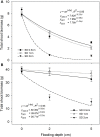Optimizing Sowing and Flooding Depth for Anaerobic Germination-Tolerant Genotypes to Enhance Crop Establishment, Early Growth, and Weed Management in Dry-Seeded Rice (Oryza sativa L.)
- PMID: 30532759
- PMCID: PMC6265439
- DOI: 10.3389/fpls.2018.01654
Optimizing Sowing and Flooding Depth for Anaerobic Germination-Tolerant Genotypes to Enhance Crop Establishment, Early Growth, and Weed Management in Dry-Seeded Rice (Oryza sativa L.)
Abstract
Poor crop establishment, high weed infestation, and consequent yield loss are major concerns for dry-seeded rice (DSR). Flooding after seeding helps in managing weeds but reduces seed germination and crop stand. Anaerobic germination (AG)-tolerant rice genotypes could overcome these problems in DSR. Screenhouse experiments were established to evaluate the effect of seed sowing depth (SD) (0.5 cm, 1 cm, and 2 cm) and flooding depth (FD) (saturated, 2 cm, and 5 cm) on crop establishment, early growth, and weed competitiveness in DSR using AG-tolerant genotypes (Khao Hlan On, Ma-Zhan Red, IR64+AG1, and IR64). Echinochloa crus-galli, Ludwigia hyssopifolia, and Cyperus difformis were used in the weedy treatment. Rice plants reached maximum emergence 9-13 days later under flooding compared with saturated conditions. Crop emergence decreased by 12-22% at 0.5 and 1 cm SD and by 48-60% at 2 cm SD, when combined with 2 or 5 cm FD compared with saturated conditions. The 2 cm SD reduced seedling emergence by 23-42% in Khao Hlan On and Ma-Zhan Red, by 62-70% in IR64+AG1, and by 90-92% in IR64 under flooding. Initial growth in rice plant height was slow under flooding but increased progressively after the seedlings emerged from water and the final height was not affected by FD. Leaf area, total shoot biomass, tiller density, and leaf number per pot of rice were higher at 1 cm SD (P< 0.05), but decreased drastically at 2 cm SD under flooding. The emergence of E. crus-galli and L. hyssopifolia decreased by 53-65% and 89-95%, respectively, but increased by 49-68% in C. difformis under 2 and 5 cm FD, respectively, compared with saturated conditions. The shoot biomass of the weeds followed the same trend. Khao Hlan On showed the highest weed-competitive ability under all FD while the biomass of IR64+AG1 and IR64 decreased by 10-14% due to weed competition under 2 cm FD. The 1 cm SD showed better growth for all genotypes under different FD. The 2 cm FD is sufficient to have a significant control of problematic weed species. The tolerance of AG of rice genotypes should be further enhanced to increase their weed-competitive ability.
Keywords: AG tolerance; Cyperus difformis; Echinochloa crus-galli; Ludwigia hyssopifolia; direct seeding; weed competition.
Figures











References
-
- Ampong-Nyarko K., De-Datta S. K. (1991). A Handbook for Weed Control in Rice. Manila: International Rice Research Institute.
-
- Anwar M. P., Juraimi A. S., Puteh A., Man A., Rahman M. M. (2012). Efficacy, phytotoxicity and economics of different herbicides in aerobic rice. Acta Agric. Scand. Sect. B Soil Plant Sci. 62 604–615. 10.1080/09064710.2012.681060 - DOI
-
- Armstrong W., Drew M. C. (2002). “Root growth and metabolism under oxygen deficiency,” in Plant Roots, ed. Wasel Y. (New York, NY: The hidden half; ).
-
- Awika J. M. (2011). “Major cereal grains production and use around the world,” in Advances in Cereal Science: Implications to Food Processing and Health Promotion, eds Awika J., Piironen V., Bean S. (Washington, DC: ACS Symposium Series; ), 1–13. 10.1021/bk-2011-1089.ch001 - DOI
LinkOut - more resources
Full Text Sources

